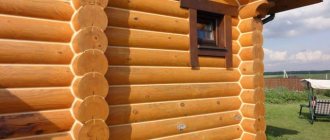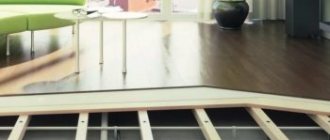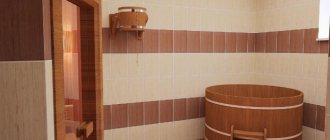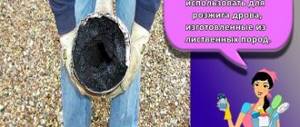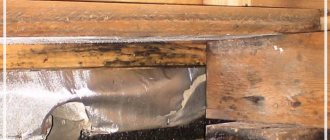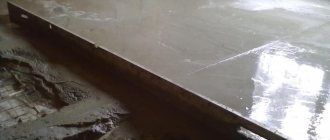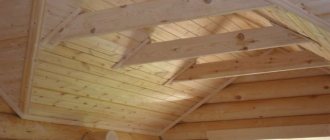Why do logs rot in bathhouses?
The wooden floor in the bathhouse is pleasant underfoot, retains heat well, looks and smells nice. But the conditions for boards in this building are harsh. High temperature and humidity create conditions for harmful processes - rotting and fungal growth. Rotting is visible on the floor boards, but if the pathological process has affected the joists, the problem will not become noticeable soon.
Causes of log rotting:
- Gaps in the floor through which water penetrates under the boards;
- Poor ventilation, lack of windows;
- The oven is of insufficient size and does not provide the required temperature;
- Improper drainage around the building;
- Presence of rotting areas on floor boards.
If the owner does not carefully monitor the wooden floor in the bathhouse, rotting can destroy the structure in 2-3 years.
Signs of rotting logs:
- Crackling and creaking of the floor with intact boards;
- Mobility of boards for no apparent reason;
- The smell of rot and mold that remains even after cleaning.
Rotten joists do not support the floor Source ytimg.com
Rotting beams release harmful substances into the air, this process intensifies at high temperatures.
Entering such a bathhouse does not make a person healthier, but harms the respiratory system and skin. If the process has gone too far, the joists may break under the weight of people at the most inopportune moment.
Choice of impregnation and antiseptic
How to treat the floor in a bathhouse so that it does not rot? This question is asked by any owner who is familiar with the properties of wood and intends to build a bathhouse with his own hands for the first time.
When choosing a wood processing method, you need to know and take into account its properties and how it resists moisture. It is because of the increased humidity that rot and mold develop in the pores, and insects love wood weakened by them.
Larch, pine, oak, and ash are more resistant to moisture. These breeds are less demanding to process. The wood of oak and ash is so hard that bugs do not often live in it, and moisture does not penetrate well through the small pores on the surface. Larch and pine contain many natural resins that have preservative properties. It is enough to dry such wood before use and coat the finished parts with compounds that often also have decorative properties.
Moisture-resistant wood species
Birch, spruce and fir are less protected by nature from moisture. Before using these species, it is necessary not only to dry the material, but also to treat it with various fungicidal compounds that kill fungal spores in the wood.
Linden and maple products are very poorly resistant to damage by biological pests. Such materials must be protected both during preparation for use and after use by coating and painting finished products with non-washable compounds. Products made from these species are not recommended for use outdoors or for flooring in wet rooms - in a sink, in a steam room.
High resistance to water is characteristic of wood from plants growing in tropical latitudes. Examples of such trees are teak, mahogany, and merbau.
Mahogany boards
Constant exposure to heat and high humidity with slow tree growth contribute to the creation of a strong and durable structure. These breeds are often not treated with any means at all and are used in bathhouses for constructing floors, shelves, and benches. But products from these breeds have a high price.
What helps against rotting
Rot, like any disease, is easier to prevent than to treat. You need to take preventive measures when laying the floor - immediately treat the beams and boards with a protective compound. When choosing how to treat logs under the floor in a bathhouse, you need to pay attention to the type of substance (impregnation in a bathhouse is more reliable than a film-forming composition) and its interaction with water (the substance should not be washed out).
Industrial impregnation
This technique is used in factories. Wooden products are impregnated with protective substances at high temperature and under pressure. Industrial impregnation protects against rotting, fungi and bacteria. There are fire-fighting compounds and rodent repellents. The main advantage is that industrial impregnation penetrates to the maximum possible depth. The disadvantage is that such logs are more expensive than untreated ones.
Industrial processing solves many problems Source archispace.com
See also: Catalog of companies that specialize in paints and varnishes and related work
Antiseptic impregnations
To save money, you can buy untreated timber and impregnate them with a protective compound yourself. If you properly organize ventilation and drainage in the bathhouse, then such logs can be laid on any base, including earthen ones. Antiseptics for self-treatment are inferior to industrial ones in terms of penetration depth, but if the logs were not initially affected by rot, this does not matter.
Most often in stores you can find impregnations and “Neomid”. When choosing, you need to look at the labeling - the important ones are “for baths and saunas.” They mean that the substance does not contain volatile toxic compounds and is stable at high humidity and temperature.
Operating rules:
- Impregnation is carried out after laying the lags, so as not to disturb the protective layer during fastening;
- You need to work at temperatures from +10⁰ to +50⁰, having previously ventilated the room;
- For application use a brush, roller or spray;
- The impregnation is applied evenly, then allowed to dry for an hour;
Impregnation must be applied evenly Source folksland.net
- The procedure is repeated three times - this creates the most reliable protection against moisture.
After the last layer has dried, you need to additionally coat the logs with varnish, this will protect the impregnation from washing out. The same algorithm works for floor boards. No additional protective equipment is required.
The most thorough treatment is carried out in the washing room - this is the wettest place in the bath. It is not necessary to use varnish in the steam room, but it is important that the impregnation is resistant to temperature. In other rooms, you can limit yourself to a universal mixture for interior work.
The advantages of this treatment are that the owner himself selects the intensity of impregnation and does not overpay for excess substance where it is not needed. Bioprotective agents protect not only from rotting, but also from mold and bacteria. There are also fire-bioprotective agents that will protect the bathhouse from all types of harmful influences.
Disadvantages: time and labor costs. If the treatment was carried out before installing the logs, there is a risk of damaging the protective layer. If you carry it out after installation, the lower parts of the beams will remain untreated. This is not critical on a concrete or pre-treated wood base, but is risky if the base is earthen.
Insect protection: recommendations
To combat insects, wooden joists should be treated with an Antizhuk septic tank, which will provide reliable protection against insects for many years.
Many residents of wooden houses experience discomfort due to the presence of insect pests in them. This is a rather unpleasant phenomenon that must be dealt with. The location of the logs is warm and comfortable, so insects often settle here. This can lead to the fact that within a few years the floor will become unusable and will have to be replaced.
Related article: What to do if a child eats wallpaper glue
To prevent this from happening, floor joists must be treated with protective compounds. Resin is considered the most effective and proven remedy. It needs to be prepared to be able to apply it. To do this, the resin is heated in a metal container.
When it has completely softened, you can begin to cover the joists with it. This is done simply with a regular paint brush. After the procedure, not a single insect will be able to get into the tree structure. The resin creates a fairly durable protective layer that practically does not collapse over time.
Chemical insect control products are also available on the modern market. However, when choosing them, you should always take into account that only safe components should be used at home. They help protect wood and protect the human body from harmful fumes. Therefore, when purchasing such a product, you must read its composition. It should not contain components harmful to the body.
Thus, currently there are several main types of processing of wooden logs. All these measures are aimed at solving problems associated with the appearance of insects and protection against microorganisms that cause decay. Both measures are necessary. If the logs are not treated with anything after installation, then there is a high probability that within the next 5 years they will become unusable. This will lead to repairs that will require significant costs.
The best posts
- How to make a plasterboard ceiling in the kitchen with your own hands
- How to paint drywall: little tricks
- Socket boxes for drywall: correct selection and installation
- Grouting drywall joints: materials and techniques for performing the work
- Epoxy resin, application
- How to cover a radiator with plasterboard without losing heat in the room
- Repair of plasterboard ceilings: we fix the problem ourselves
- Machine for the production of profiles for plasterboard: production of frame elements
How to deal with rot
If the treatment turned out to be insufficient and the joists begin to rot, you can deal with the problem without completely replacing the floor. You need to start the fight against rot with thorough ventilation. Then you need to remove the floor boards, inspect the joists and find all areas of rot. Each affected area must be treated with one of the following compounds:
- Industrial products against rot and mold or other chlorine-based substances. They are used according to the instructions.
- A solution of a mixture of iron sulfate, potassium alum and table salt . Apply to the affected area with a brush. Completely destroys bacteria and fungi. The treatment must be repeated after a month for maximum results.
- Setting fire to sulfur . In the bathhouse, you need to tightly close the windows and ventilation, and exclude access to pets. Sulfur powder is poured into an iron can, set on fire and quickly left the room. Close the door tightly behind you and leave it overnight. In the morning, the bathhouse is opened, the air is disinfected with a bucket of quicklime, and then ventilated. The method is effective, but fire hazardous.
- Hydrogen peroxide . Copes with mold and inhibits the rotting process. Safe for humans at any temperature. The solution is poured onto the affected areas and around them in a thin stream.
To work you need a large bottle of peroxide Source peroxide-prom.ru
What products can be used for internal processing
The choice of antiseptic for treating interior spaces must be approached very responsibly.
It is necessary to choose preparations intended for internal use that are safe for humans and animals. Typically, water-based antiseptics are used for protection inside the house, which do not contain harmful components, do not emit toxins, do not have an unpleasant odor, are breathable and moisture-resistant.
If there is blue discoloration or dark spots on the wood, these areas are treated with an active oxygen-based bleach that does not contain chlorine.
After antiseptic treatment, fire-retardant impregnation of the internal walls of the house is performed. To protect against fire, you can use salt and non-salt fire retardants. Preparations of the first type are inexpensive, but they are not able to fully protect the house from fire.
Non-salt fire retardants are more preferable, as they provide a high degree of fire protection for the home. They penetrate deeply into the wood structure, protect the wood from fire and prevent the spread of flame.
How to prevent rotting
The main cause of rotting is construction errors. If they are allowed, then even industrial impregnation will not provide reliable protection against rot and mold. During construction it is necessary to provide:
- Drainage of water from the foundation . Water should not accumulate under the floor or near the bath; a good drainage system is required.
Water should not accumulate near the bathhouse Source vodolov.ru
- Ventilation holes . Vents will prevent moisture from accumulating. To prevent heat from escaping through them, they are closed during washing.
- Window in the washing room and steam room, wide doors . Through them you can quickly release accumulated steam after washing.
- Quality of materials . A tree without cracks, chips, or signs of rot will remain healthy longer.
- Oven size . It must match the size of the bath. A stove that is too small will not provide the required temperature in the steam room, but will create a humid and warm environment in the corners and under the floor.
- Quality of floor installation . If the boards fit tightly, water will not be able to get under the floor.
- Distance from shelves to walls . There should be no gaps between them; this is a direct path to sources of rot.
The bathhouse should be regularly ventilated and cleaned using chlorine cleaners, and the boards should be inspected for rotten areas. This will ensure maximum safety of wooden structures.
Measures for waterproofing floors laid on support posts
For comprehensive protection of wooden joists and floors:
- Inside the mounted base of the future house, holes are dug at a distance of 0.8 -1.5 m. This is the meta location of future pillars. A sand and crushed stone cushion is placed at the bottom of each pit. A plastic film is laid on top of it, which should extend to the surface of the soil by 25 - 30 cm.
- The support columns are laid out or cast from concrete. After the solution dries or the concrete hardens, they are treated with a special waterproofing mastic.
- The entire surface of the underground is lined with roofing felt so that it extends 20 cm onto the walls of the base. Sheets of roofing felt are joined using mastic. It is better not to cut the material in the corners, but to carefully fold it into folds. Thus, something like a sealed container is formed in the underground.
- The upper sections of the columns are lubricated with bitumen and pieces of roofing material are glued to it, designed to protect the basement beams or joists from contact with brick or concrete.
- Floor beams are laid on the columns.
- Each beam is equipped with two cranial bars intended for laying the subfloor.
- Install the subfloor. Usually these are low quality boards or even slabs. But it is worth remembering that the wane must be cleaned, and the boards themselves must be treated with waterproofing impregnation.
- Often the surface of the subfloor, especially if it is cracked, is coated with a clay solution. It is an additional waterproofing layer.
- Logs are installed along the beams.
- Then the entire subfloor is covered with roofing felt or film so that the joints overlap by 10 - 15 cm. The joints are secured with tape.
- If floor insulation is provided, then insulation is laid over the film, which is covered on top with a vapor barrier film secured to the joists.
- A floor made of prepared and treated floorboards is installed along the joists.
Compliance with the given work technology allows you to obtain triple protection of the floor from moisture: roofing felt on the ground, clay on the subfloor, film and vapor barrier directly under the floor covering.
If you decide to use a concrete screed as the base of the floor, then you need to proceed as follows:
- Rolled waterproofing material (most often roofing felt) is laid on the prepared soil base so that it extends 10 - 15 cm onto the walls of the base. If the base is wet, then the material can be laid in 2 layers - along and across the house.
- Sheets of roofing material are connected to each other using heated bitumen mastic, achieving maximum tightness.
- Insulation – extruded PPS or expanded clay – is installed over the roofing felt.
- A layer of waterproofing - polyethylene film - is again laid on top of the insulation. She is also taken to the walls.
- Next, reinforcement mesh is mounted along it and beacons are installed.
- A layer of fine concrete screed is poured and leveled over the beacons and waited for it to dry completely.
Sometimes, for reliability, two layers of screed are made, separated by a layer of waterproofing and. The surface of the screed is strengthened with strengthening, impregnating and waterproofing compounds, which create a durable moisture-proof film on the surface. For this purpose, asphalt concrete, bitumen, liquid rubber, and bentonite are used. After this, you can begin installing wooden floor structures.
Thus, protecting a wooden floor from moisture consists not only and not so much in the processing of the wood itself, but is a whole complex of measures, the implementation of which guarantees multi-layer waterproofing of the future floor.
There are many materials that are alternatives to natural ones. But, despite this, floors continue to be made from wood, and not only in wooden houses. There is an explanation for this: wood flooring has a number of unique properties, such as low thermal conductivity, good sound insulation and aesthetic appeal. In addition, this material is environmentally friendly and harmless to humans. However, in order for such a floor to serve as long as possible, it is necessary to take a number of measures to protect it from the harmful effects of high humidity in the room. Wooden floors require waterproofing. It does not matter what exactly it is made of: fiberboard, chipboard or OSB: any porous structure absorbs moisture, which subsequently leads to the formation of cracks, warping and rotting of the wood. To prevent this, it is necessary to apply a continuous protective layer extending onto a vertical surface - up to 30 cm. We will tell you in more detail how and how this is done.
Waterproofing a floor in a wooden house, as in one built from any other material, can be done using various methods: there are pasting, impregnation, painting and casting.
Pasting involves the creation of a continuous multi-layer carpet from bitumen, bitumen-polymer or polymer materials. Before laying the first layer, the base (concrete floor slab or subfloor made of boards) must be cleaned, leveled and primed. In the case of plank or log floors - fire retardants and antiseptics. After this, sheets of waterproofing material are laid. If it is not possible to use a whole panel, the different parts are laid with an overlap of at least 100 mm. The joints must be taped. The next layer is placed on top of the mastic, which is used to treat the previously laid material. The type of mastic is selected depending on the waterproofing agent used.
Pasted waterproofing of the floor using a material with a foil surface
After such preparation, you can install a finished wooden floor, not forgetting that it is also necessary to treat its back side with protective agents. The last stage is applying a protective coating to the front surface of the floor.
Painting waterproofing is easier to do: to do this, you need to apply several layers of polymer or bitumen varnish to the base. It will fill all the cracks and pores, preventing moisture from penetrating the structure of the material. But this method has some disadvantages: when the lower level floor freezes, the protective layer becomes covered with a network of cracks. The service life of painted waterproofing is not long: even under normal operating conditions it must be renewed every 5-7 years.
Painted waterproofing reliably clogs the pores of natural materials
Impregnated insulation consists of treating a sub-floor wood floor with water-repellent substances that have been popular for many years - tar, drying oil or relatively new ones created on the basis of acrylic, silicone or other synthetic binders. The base must be completely dry and clean before applying them.
Cast waterproofing is the most expensive and difficult to perform. But its effectiveness makes it worth thinking about protecting a wooden floor in this way. The technology for its creation is as follows. To begin with, the base is cleaned and treated with primer, after which laying of welded or glued rolled material, which is suitable as hydroglass insulation, roofing felt, etc. Then a cement-sand mortar is prepared, into which liquid glass is added: this solution is used to make a screed. The thickness of the screed is at least 5 cm, and a metal mesh is placed in it for strength. After drying, the resulting surface is covered with a waterproofing mixture made on the basis of waterproof cement. Additional strength is given to such a base using a special substrate, on top of which a wooden floor is mounted.
Cast waterproofing is the most effective way to protect a wooden floor
Briefly about the main thing
When choosing how to cover the boards in a bathhouse on the floor from rotting and moisture, it is better to give preference to industrial compounds that are sold in hardware and country stores. This will reduce the risk of damage to the tree and harm to human health. Properly organized ventilation and water drainage will eliminate the need to deal with rot. Products that are effective against rot, protect against mold, fungi and microbes, and may have additional fire protection.
Ratings 0
Folk remedies
Wooden floor joists can be treated not only with factory-made compounds, but also with all kinds of folk remedies.
- Transformer oil. When treating logs with this chemical, the oil penetrates deeply into the wood structure and embalms it. There is no scientifically proven evidence of the effectiveness of the method, but judging by the reviews of craftsmen, transformer oil really helps protect wood.
- Engine oil. Often used to protect logs and used motor oil. There is a significant drawback to its use - the waste has a very unpleasant and persistent odor. Moreover, the smell can persist for many years - until it completely disappears. Therefore, mining cannot be used everywhere: in technical premises, but not in residential buildings. The advantage of this technique is the low cost or even free use of used oil.
- Resin. Resin-based compositions, for example, coniferous resin or birch tar, protect wood well from rot, fungus, and pests. The main disadvantage of resinous compositions is their vulnerability to fire hazards. In addition, the resins have a persistent odor that is difficult to weather.
- Brine. According to some craftsmen, salt can protect wooden logs. To make the solution you will need 100 grams of salt per liter of water.
We suggest you familiarize yourself with: Mold antiseptic spray
When choosing a specific composition for protecting lags, you should be guided by your goals. Of all the options described above, the ideal choice is a fire-retardant substance that has the maximum spectrum of action.
Additional points
Thanks to the antiseptic, the wood is protected from insects, rot, fungi, and so on for up to 35 years.
There is another treatment option for rot, which is to use creosote.
It is used to process railway sleepers. During the application process, an unpleasant odor is also formed, which is very difficult to get rid of. Discomfort in the room is guaranteed.
The modern market offers many solutions to this problem.
You can treat the logs under the floor using a variety of antiseptics; it does not necessarily have to be Senezh. When choosing, you need to take into account that not all trees are the same in their properties and structure. The antiseptic is selected depending on the specific option used in the construction of the house and logs.
Additional points
Thanks to the antiseptic, the wood is protected from insects, rot, fungi, and so on for up to 35 years.
There is another treatment option for rot, which is to use creosote.
It is used to process railway sleepers. During the application process, an unpleasant odor is also formed, which is very difficult to get rid of. Discomfort in the room is guaranteed.
The modern market offers many solutions to this problem.
You can treat the logs under the floor using a variety of antiseptics; it does not necessarily have to be Senezh. When choosing, you need to take into account that not all trees are the same in their properties and structure. The antiseptic is selected depending on the specific option used in the construction of the house and logs.
How to treat joists and subfloors
Joists are one of the most important components of flooring in a home. According to their purpose, they are supporting elements on which floor boards are laid. Thanks to the joists, the rigidity of the entire floor structure is ensured. Therefore, it is important to ensure their resistance to decay and microorganisms. Moisture resistance can be achieved by special wood treatment. What and how to process lags will be discussed below.
- Logs and external environment
- Classification of compositions for treating lags
- Branded formulations
- Fire-retardant substances
- Bioprotective compounds
- Leave-in antiseptics
- Folk remedies
Classification of compositions for treating lags
Chemicals for protecting wood when installing floors, according to building codes and regulations, are divided into several types:
- surface antiseptics;
- impregnation;
- film-forming compositions.
Water-soluble compounds include fluorides, borates (washable antiseptic substances), as well as complex compounds containing chromium, arsenic and copper (difficult to wash out antiseptics). Organics include compositions based on alkyds, urethanes and acrylics. A large group of oil compositions includes substances based on coal, anthracenes and other compounds of this kind. Oil preparations also include formulations based on vegetable oil, tar, and rosin.
Glazing compounds are used for surface treatment. By surface application we mean a depth of 1-3 millimeters. Impregnations are capable of penetrating 15-35 millimeters into the wood structure.
Note! Non-washable preparations are used to protect parts subject to heavy rainfall and regular wet cleaning.
According to their functionality, antiseptic agents are classified as follows:
- preservatives;
- fireproof;
- transport;
- whitening.
Chemicals can be roughly divided into factory-produced compounds and folk remedies.
Processing of logs according to the requirements of standards
The standards indicate how to treat logs in a bathhouse. Solutions of borax, silicate glue, potassium dichromate, and vinegar are usually used. Compositions are now being produced that have excellent antibacterial qualities and are absolutely harmless to others. Such compositions are made according to a recipe that is recommended in accordance with GOST requirements.
To protect lags, certain brands of factory-made impregnations are used. So, what should you use to saturate logs in a bathhouse? You can choose Tikkurila, Belinka, Bioks or any other brands of mixtures. They should be used according to the instructions indicated on the packaging. A distinctive feature of compositions for protecting logs in a bathhouse is to ensure the least shrinkage of wood and clogging of pores on cuts of boards. These compositions are not required to protect the wood from sunlight, sudden changes in temperature and emphasize the natural pattern.
How to impregnate wood to prevent it from rotting
Wood is one of the most common building materials in the world. It is widely used both for the construction of buildings and for interior decoration, due to its strength, durability and excellent aesthetic characteristics. Since this is a natural material, it is susceptible to biodegradation under the influence of moisture and microorganisms, so it is important to prevent the putrefactive process. How and what is used to treat wood against rotting?
Causes of rotting
The main enemy of wood is fungus, which causes it to rot. “Contamination” can occur as a result of improper storage and transportation. Active reproduction of microorganisms provokes a whole set of accompanying factors:
- High air humidity – up to 90%.
- Stagnation of oxygen.
- Exposure to moisture.
- Temperature changes and freezing.
- Prolonged contact with the soil.
Fungus on wood
Prevention of wood rotting
There are many preventive measures to prevent mold from appearing before construction begins. Since the moisture content of wood after felling varies from season to season, it must be dried under natural conditions for at least 1 year.
There are a number of methods to prevent biodegradation processes and the negative effects of moisture:
- Waterproofing.
- Coloring with special compounds.
- Roof waterproofing.
- Heat and vapor insulation.
The foundation for a wooden structure should always be located above ground level, and it is also necessary to equip a drainage system and blind area. A garden near a house with tall trees is a bad idea as they will interfere with natural drying.
Also, to prevent putrefactive processes, it is necessary to inspect the house every year. If signs of fungus are detected, the material should be sampled to determine its moisture content and density.
Preventative measures are important, since wood affected by the fungus has many physical indicators reduced: it becomes up to 30 times less hard, 3 times less dense. All this leads to distortion of window openings, movement of walls, even to the loosening of the structure.
If biodegradation has begun, it can be contained using special means - both store-bought and folk.
Antiseptics
If mold has already appeared, its growth can be prevented using antiseptic agents. They suppress the proliferation of microorganisms on wooden surfaces that cause rotting.
Today in the store there is usually a lot to choose from antiseptics
When choosing a specific product, you should pay attention to such indicators as possible harm to humans and animals, anti-corrosion properties and impact on the quality of wood.
All antiseptics are conventionally divided into 3 groups:
- Water-soluble products.
- Oily.
- Pasty.
A special category includes products that are soluble exclusively in organic substances.
Water-soluble antiseptics
The most common impregnation is sodium fluoride. Its popularity is explained by a set of significant advantages:
- high efficiency;
- good penetrating ability;
- no unpleasant odor.
BBK-3 is a solution of borax and boric acid. It is relatively safe for people and animals, and also has excellent penetrating ability.
GR-48 is a drug based on pentachlorophenol. It protects the boards not only from the negative effects of moisture and biodegradation, but also from blue stains.
Often, products are used that contain several active ingredients at once - for example, CCC based on chromium and zinc chloride. However, this impregnation has 2 significant disadvantages: toxicity and the possibility of staining the wood.
Oily and pasty antiseptics
Oily antiseptics are considered the most powerful of their kind. They are used to protect wooden walls from the negative effects of moisture and soil. However, oily impregnation also has two serious disadvantages: a strong unpleasant odor and the ability to color the wood dark brown.
Paste antiseptics consist of three main components:
- Water-soluble antiseptic.
- Filler.
- Clay or bitumen as a binder.
Organically soluble antiseptics are products like PL containing pentachlorophenol and petroleum products. However, due to their high toxicity, they are rarely used.
The use of organically soluble antiseptics is justified for treating wood when exposed to moisture in order to avoid drying. When using these products, you need to take care of personal protection: gloves and a respirator.
How to apply impregnation to wood
In order to treat wood with an antiseptic composition, different methods are used. The most effective way is to immerse the material in baths with the active substance. The only disadvantage of the method is its high cost.
The second method is impregnation using autoclaves. This method is based on high pressure, which promotes deep absorption of the composition into the material.
Often special pastes are applied to the boards - they have good penetrating ability and effectively protect the material from fungus. Antiseptic agents are often applied using rollers, brushes, or simply sprayed from a spray bottle.
Applying antiseptic with a brush or spray
It is always necessary to apply the composition to a dry surface that has not been coated with varnish or enamel, since in these cases the product will not be able to be absorbed.
Folk remedies for impregnation
If the putrefactive process has not had time to grow significantly, folk remedies will help prevent further destruction of the tree:
- Silicate glue.
- Soda and vinegar.
- Potassium dichromate solution.
- Copper sulfate.
- Resin.
- Salt and boric acid.
The easiest way is to use silicate glue. It is necessary to dilute it with water, and apply the resulting solution to areas where biodegradation occurs. You can also treat the rotting areas with soda, and spray vinegar from a spray bottle on top.
Potassium dichromate is used by mixing in equal proportions with sulfuric acid. The resulting composition should be used to treat not only the boards on the street, but also up to 50 cm of the soil layer.
